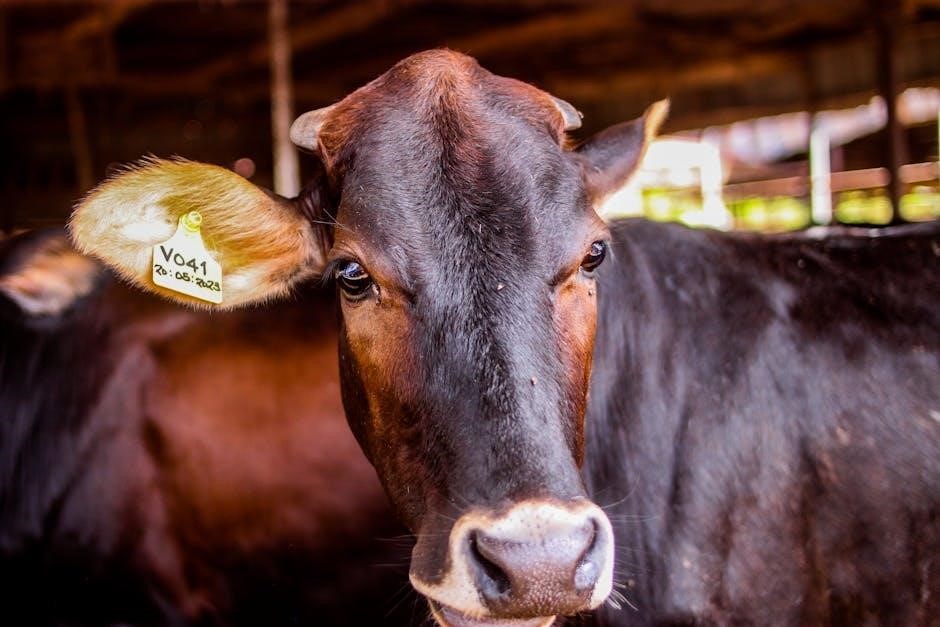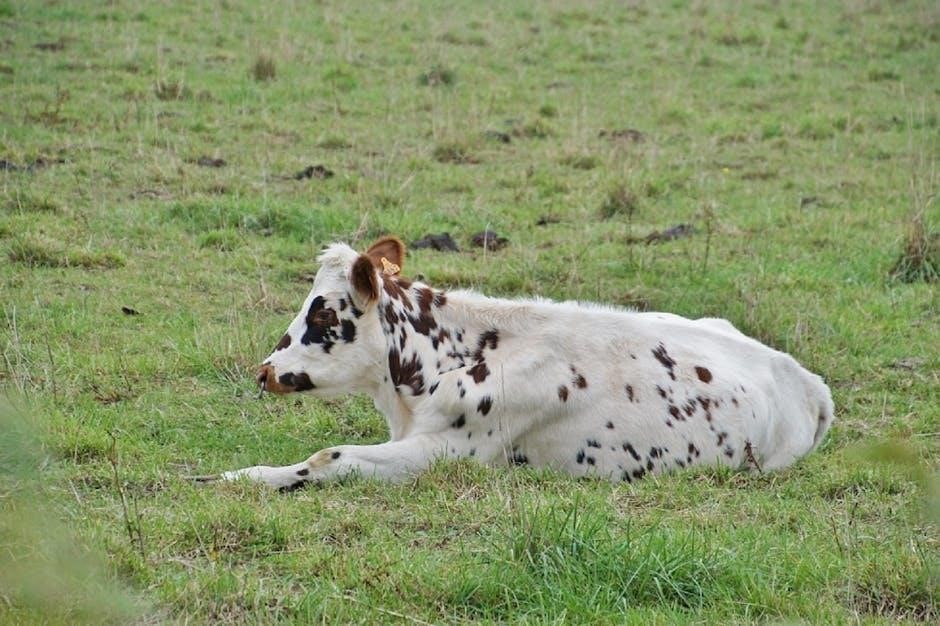Liquamycin LA-200 is a broad-spectrum oxytetracycline antibiotic specifically formulated for cattle, offering effective treatment against bacterial infections, including respiratory diseases and anaplasmosis, with FDA approval for veterinary use․
1․1 Overview of LA-200 and Its Importance in Veterinary Medicine
Liquamycin LA-200 is a long-acting oxytetracycline injection designed for use in cattle, offering broad-spectrum antibiotic efficacy against bacterial infections․ It plays a critical role in veterinary medicine by effectively treating respiratory diseases, anaplasmosis, and other bacterial conditions․ Its prolonged action ensures sustained therapeutic levels, reducing the need for frequent dosing․ This makes it a valuable tool for maintaining herd health, preventing disease spread, and promoting productivity in livestock․ The product’s importance lies in its ability to address common and severe infections, supporting the overall well-being of cattle and the sustainability of agricultural practices․ Proper administration as per veterinary guidelines ensures safety and efficacy, making LA-200 a cornerstone in cattle healthcare․
Recommended Dosage of LA-200 for Cattle
The recommended dosage of LA-200 for cattle is 9 mg per pound of body weight, administered intramuscularly, ensuring effective treatment for bacterial infections like pneumonia and anaplasmosis․

2․1 Dosage for Bacterial Pneumonia and Anaplasmosis
For bacterial pneumonia and anaplasmosis in cattle, the recommended dosage of LA-200 is 9 mg per pound of body weight, administered intramuscularly; This single-dose regimen is effective for treating these conditions, eliminating the need for repeated injections․ The product’s long-lasting action ensures sustained therapeutic levels in the bloodstream, making it a practical choice for farmers and veterinarians․ LA-200 is particularly beneficial in cases where retreatment is impractical due to handling challenges or husbandry conditions․ Always follow the prescribed dosage to ensure efficacy and safety, and observe the 28-day withdrawal period before slaughter or milk consumption․
2․2 Dosage for Other Indicated Diseases
For other indicated diseases in cattle, such as foot rot, diphtheria, and scours, the recommended dosage of LA-200 ranges from 3 to 5 mg per pound of body weight per day․ This dosage is typically administered via intramuscular, subcutaneous, or intravenous injection, depending on the severity of the condition․ Severe cases may require the higher end of the dosage range to ensure effectiveness․ The product’s versatility allows for tailored treatment plans, making it a reliable option for various bacterial infections․ Always adhere to the prescribed dosage and administration guidelines to ensure optimal therapeutic outcomes and safety for the animal․

Administration Methods
LA-200 can be administered via intramuscular, subcutaneous, or intravenous injection, ensuring effective delivery of the antibiotic to treat bacterial infections in cattle․ Maximum dosage per injection site is 10 ml․
3․1 Intramuscular Injection Guidelines
For intramuscular injection, LA-200 is recommended at a single dose of 9 mg per pound of body weight, administered in the neck region․ This method ensures effective absorption and minimizes discomfort․ The injection should be given in a clean, dry area to reduce the risk of infection․ Maximum volume per injection site should not exceed 10 ml to avoid tissue irritation; Proper handling and hygiene practices are essential to maintain product potency and animal safety․ Always follow veterinary guidance for accurate administration․
3․2 Subcutaneous and Intravenous Administration
LA-200 can also be administered subcutaneously or intravenously at a dosage of 3-5 mg of oxytetracycline per pound of body weight daily․ Subcutaneous injections should be placed under the skin, typically in areas with loose skin, to minimize discomfort․ For intravenous use, the solution must be administered slowly and carefully to avoid adverse reactions․ Both methods are effective for treating severe infections, but intravenous administration is typically reserved for critical cases․ Maximum volume per injection site should not exceed 10 ml to prevent tissue irritation․ Always ensure proper aseptic technique to maintain safety and efficacy․ Withdrawal times for meat and milk apply as specified for intramuscular use․

Withdrawal Times
LA-200 requires a 28-day slaughter withdrawal period in cattle and swine, and milk from treated animals must be discarded during treatment and for 24 hours after the last dose․
4․1 Meat and Milk Withdrawal Periods
For cattle treated with LA-200, a mandatory 28-day slaughter withdrawal period is required to ensure the drug is fully cleared from the system․ Milk from treated animals must be discarded during treatment and for 24 hours after the last dose․ This ensures compliance with FDA regulations and prevents residues in meat or dairy products; Proper adherence to these withdrawal times is critical to maintain consumer safety and uphold quality standards in the livestock industry․

Safety Precautions
Handle LA-200 with care to avoid exposure․ Wear protective gloves and eyewear․ Prevent accidental overdose and ensure proper disposal to minimize environmental impact and consumer risk․
5․1 Maximum Dosage per Injection Site
The maximum recommended dosage per injection site for LA-200 in cattle is 10 mL to prevent tissue irritation․ Administering more than this volume can cause localized reactions or discomfort․ Properly distribute the dose if the required volume exceeds 10 mL per site․ This ensures optimal absorption and minimizes potential side effects․ Always follow veterinary guidelines to maintain animal welfare and drug efficacy․
5․2 Contraindications for Use
LA-200 is contraindicated in animals hypersensitive to oxytetracycline or other tetracyclines․ It should not be administered to lactating dairy cattle, as it may affect milk quality or safety․ Avoid use in animals with severe kidney or liver impairment, as tetracyclines can exacerbate these conditions․ Do not use in conjunction with bactericidal antibiotics like penicillins, as they may reduce efficacy․ The product is not intended for non-lactating cattle only, and meat withdrawal periods must be strictly followed․ Exceeding the maximum dosage per injection site or disregarding contraindications can lead to adverse reactions, including injection-site inflammation or systemic complications․ Always consult a veterinarian before administration to ensure safe and effective use․

Determining the Correct Dosage
Accurate dosage calculation is essential, considering the animal’s weight, disease severity, and specific infection type․ Always consult a veterinarian to ensure proper administration and avoid under- or over-dosing․
6․1 Calculating Dosage Based on Body Weight

The correct dosage of LA-200 for cattle is determined by the animal’s body weight and the severity of the infection․ For bacterial pneumonia and anaplasmosis, the recommended dosage is 9 mg of oxytetracycline per pound of body weight, administered intramuscularly․ For other indicated diseases, such as respiratory infections, the dosage range is 3-5 mg per pound of body weight daily․ To ensure accuracy, body weight should be assessed as precisely as possible․ A single dose is often sufficient for certain conditions, while others may require repeated administration․ Always follow the veterinarian’s guidance to avoid underdosing or overdosing, which can affect treatment efficacy and animal safety․ Proper dosage calculation is critical for effective treatment and preventing resistance․
